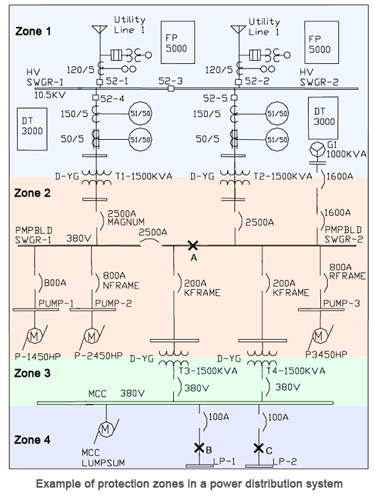The “protection zone” in an electrical power system is defined as the specific region within the system that is monitored and protected from faults by protective relays. This zone is established around each major piece of equipment within the power system.
When a fault occurs within any of the protection zones, the protective relays will call on the circuit breakers within that zone to be opened. This allows only the affected equipment to be isolated while keeping the rest of the system energized.
Protection schemes encompass the entire power system, ensuring that no piece of distribution equipment is left unprotected. The definition of a protection zone within a power system primarily depends on the rating of the apparatus, its location, and the probability of faults and abnormal conditions of the equipment.
Example of protection zones in an electrical power distribution system. Photo: EATON.
If a fault were to occur outside the zone of protection, it would remain undetected by the relays and not be cleared until physical equipment failure or a fault magnitude is great enough to cause a disturbance in another zone. For this reason, each zone of protection is designed to overlap its neighboring zone, enhancing reliability in the event of relay failure.
The probability of failure in the overlapping regions is minimal, but it may lead to additional circuit breakers within the zone tripping. Protective relays used within any protection scheme should be designed, manufactured, and applied with the following criteria:
-
Reliability – Relays must have the ability to perform correctly when needed (dependability) and to avoid unnecessary operation (security).
-
Speed – Relays must operate with minimum fault duration and minimize equipment damage.
-
Selectivity – Protective relays must provide maximum service continuity with minimum system disconnection.
-
Economics - The best relays will offer maximum protection at minimum cost.
-
Simplicity - Protective relays should contain minimum equipment, circuitry and sequence of operations.

